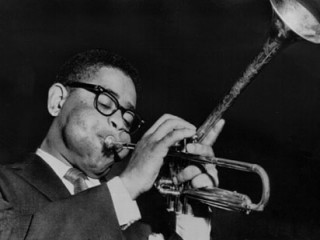
Dizzy Gillespie biography
Date of birth : 1917-10-21
Date of death : 1993-10-06
Birthplace : Cheraw, South Carolina
Nationality : American
Category : Arts and Entertainment
Last modified : 2010-09-30
Credited as : Jazz Musician and singer , bandleader, Cab Calloway Orchestra
1 votes so far
Difficult childhood
John Birks Gillespie was born October 21, 1917, in Cheraw, South Carolina, to John and Lottie Gillespie. The last of nine children, Gillespie's father was abusive and unusually strict and the youngest Gillespie grew up hard and strong.
When Gillespie was ten, his father died and left the family in terrible financial trouble. Around this time Gillespie's English teacher introduced him to music, and he soon joined the school band. At first he played the trombone, but switched to the trumpet after borrowing a neighbor's and immediately falling in love with the instrument. Over the next several years Gillespie played with local bands—to both black and white audiences—until his family moved to Philadelphia, Pennsylvania.
In Philly and New York
Gillespie played with bands in Philadelphia from 1935 to 1937 before moving to New York City. In Philadelphia Gillespie earned his nickname for his unpredictable and funny behavior. When Gillespie was in the Frankie Fairfax band in Philadelphia he carried his new trumpet in a paper bag, an act that inspired fellow musicians like Bill Doggett to call him "Dizzy."
In New York City the Teddy Hill Orchestra hired Gillespie for a European tour. By 1937—when he was only nineteen—Gillespie had already made a name for himself among New York musicians, who could not help but notice his radically fresh take on solo (single) trumpet playing. Gillespie made his first recordings with the Teddy Hill Orchestra just prior to leaving for Europe with "The Cotton Club Show."
Gillespie joined the Cab Calloway (1907–1994) Orchestra in 1939 and stayed until 1941. Calloway played the Cotton Club and toured extensively. During this period Gillespie continued to play all-night jam sessions at Minton's and Monroe's Uptown House to develop his musical knowledge and style.
Gillespie joined the Earl "Fatha" Hines band in 1942, about the same time Charlie Parker (1920–1955) did. Although Parker became famous as an alto saxophonist, he was playing tenor sax at that time. Gillespie first met Parker in Kansas City, Missouri, in 1940 when he was on tour with Cab Calloway. The two of them jammed together at the Booker T. Washington Hotel for several hours.
Bebop born on 52nd Street
A large part of the Earl Hines band departed in 1943 to form a new group headed by Billy Eckstine. Former Hines members who joined Eckstine included Sarah Vaughan (1924–1990), Gillespie, Parker, and others. Gillespie became musical director for Eckstine, whose backers got him a job on 52nd Street.
After leaving Eckstine, Gillespie substituted in the Duke Ellington (1899–1974) Orchestra for about four weeks, then formed his own group to play at the newly opened Onyx Club on 52nd Street. Gillespie had been playing bebop (a new, radically different form of jazz) whenever he could since 1940, the year he married Lorraine Willis. Now he was able to play it full time. 52nd Street became the proving ground for a new jazz style that had previously been played primarily at late night jam sessions. "The opening of the Onyx Club represented the birth of the bebop era," Gillespie recalled in his book, To Be or Not to Bop.
Also in 1944 Gillespie received the New Star Award from Esquire magazine, the first of many awards he would receive in his career. Describing the new style his quintet played, Gillespie wrote, "We'd take the chord structures of various standard and pop tunes and create new chords, melodies, and songs from them."
Gillespie's quintet and the presentation of modern jazz reached its peak in 1953—with a concert at Massey Hall in Toronto that featured Gillespie, Parker, Bud Powell (1924–1966), Max Roach (1924–), and legendary jazz bassist Charles Mingus (1922–1979). Billed by jazz critics as "the greatest jazz concert ever," it was recorded by Mingus and later released on Debut Records.
Gillespie's legacy
In 1989, the year he turned seventy-two, Dizzy Gillespie received a Lifetime Achievement Award at the National Association of Recording Arts and Sciences' Grammy Award ceremonies. The honor—one of many awarded to the trumpet virtuoso—recognized nearly fifty years of pioneering jazz performances. That same year he received the National Medal of Arts from President George Bush (1924–).
Not letting age slow him down, in 1989 Gillespie gave three hundred performances in twenty-seven countries, appeared in one hundred U.S. cities in thirty-one states and the District of Columbia, headlined three television specials, performed with two symphonies, and recorded four albums. The next year, at the Kennedy Center for the Performing Arts ceremonies celebrating the centennial of American jazz, Gillespie received the American Society of Composers, Authors, and Publishers' Duke Award for fifty years of achievement.
Although Gillespie's failing health was due to pancreatic (having to do with the organ that helps digestion) cancer, Gillespie continued to play the music that he loved late into his life. His last public appearance was in Seattle in February of 1992. Gillespie passed away quietly in his sleep on October 6, 1993, at the age of seventy-five.
















